Asean free trade area (PDF)
VerifiedAdded on 2021/11/20
|11
|2771
|104
AI Summary
Contribute Materials
Your contribution can guide someone’s learning journey. Share your
documents today.
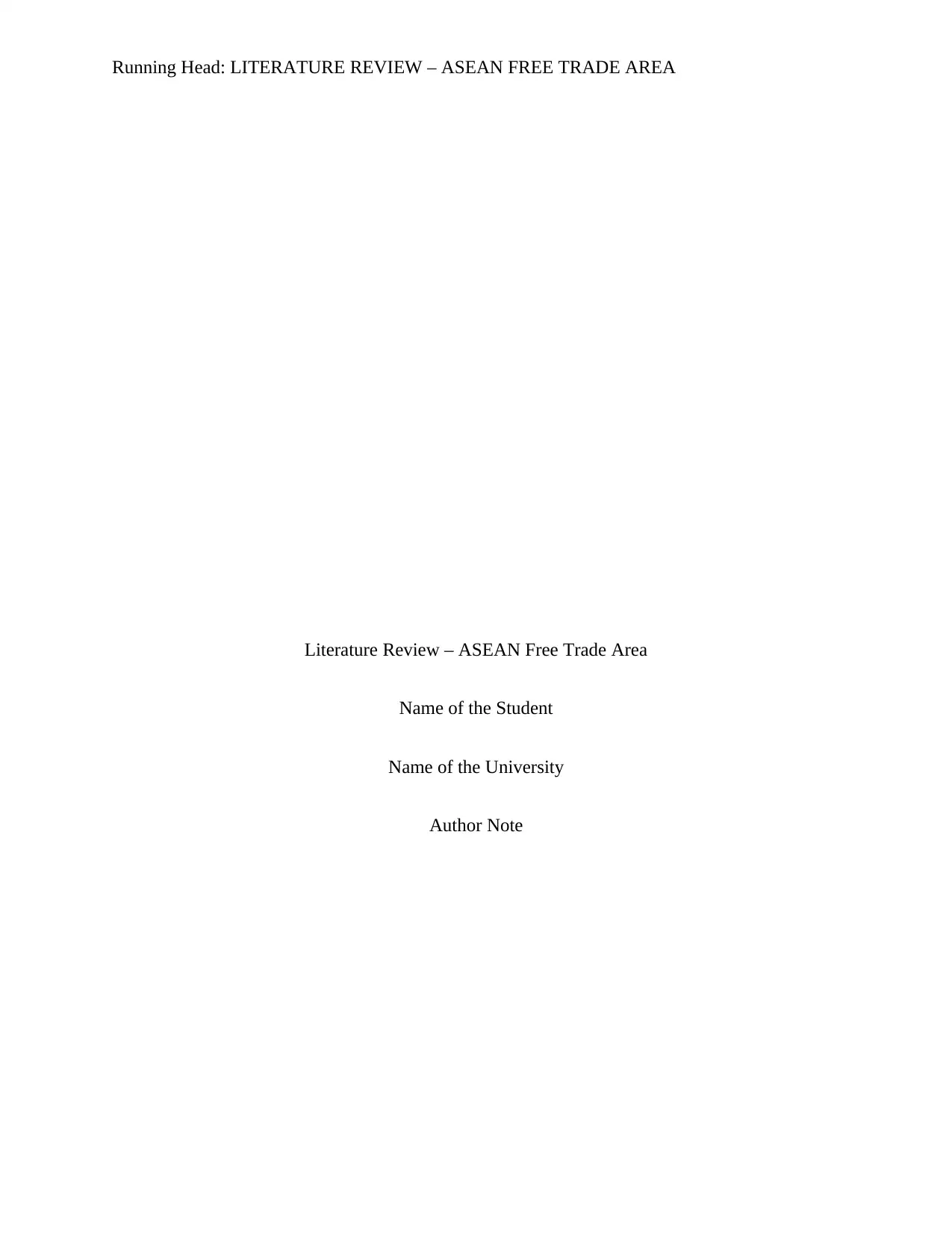
Running Head: LITERATURE REVIEW – ASEAN FREE TRADE AREA
Literature Review – ASEAN Free Trade Area
Name of the Student
Name of the University
Author Note
Literature Review – ASEAN Free Trade Area
Name of the Student
Name of the University
Author Note
Secure Best Marks with AI Grader
Need help grading? Try our AI Grader for instant feedback on your assignments.
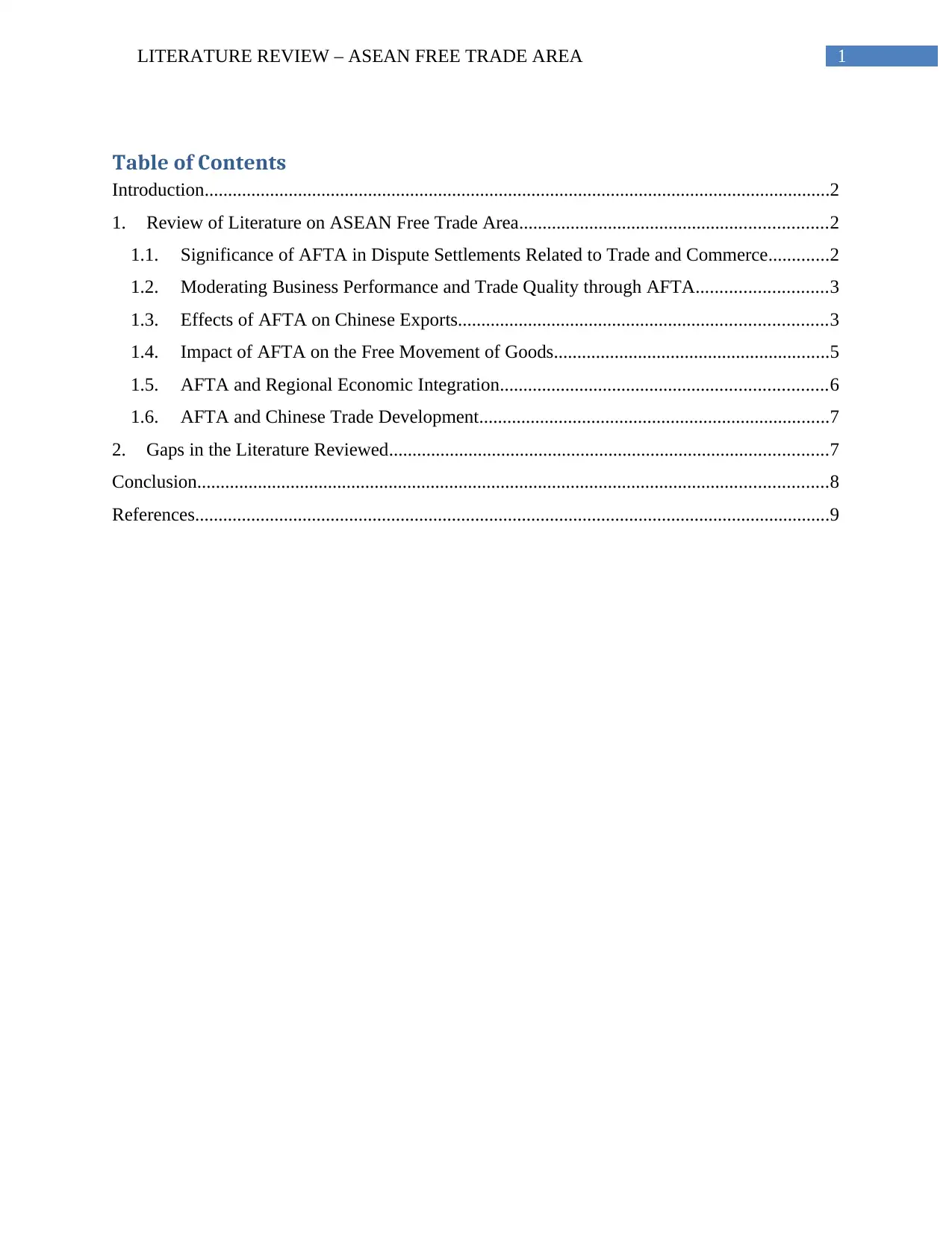
1LITERATURE REVIEW – ASEAN FREE TRADE AREA
Table of Contents
Introduction......................................................................................................................................2
1. Review of Literature on ASEAN Free Trade Area..................................................................2
1.1. Significance of AFTA in Dispute Settlements Related to Trade and Commerce.............2
1.2. Moderating Business Performance and Trade Quality through AFTA............................3
1.3. Effects of AFTA on Chinese Exports...............................................................................3
1.4. Impact of AFTA on the Free Movement of Goods...........................................................5
1.5. AFTA and Regional Economic Integration......................................................................6
1.6. AFTA and Chinese Trade Development...........................................................................7
2. Gaps in the Literature Reviewed..............................................................................................7
Conclusion.......................................................................................................................................8
References........................................................................................................................................9
Table of Contents
Introduction......................................................................................................................................2
1. Review of Literature on ASEAN Free Trade Area..................................................................2
1.1. Significance of AFTA in Dispute Settlements Related to Trade and Commerce.............2
1.2. Moderating Business Performance and Trade Quality through AFTA............................3
1.3. Effects of AFTA on Chinese Exports...............................................................................3
1.4. Impact of AFTA on the Free Movement of Goods...........................................................5
1.5. AFTA and Regional Economic Integration......................................................................6
1.6. AFTA and Chinese Trade Development...........................................................................7
2. Gaps in the Literature Reviewed..............................................................................................7
Conclusion.......................................................................................................................................8
References........................................................................................................................................9
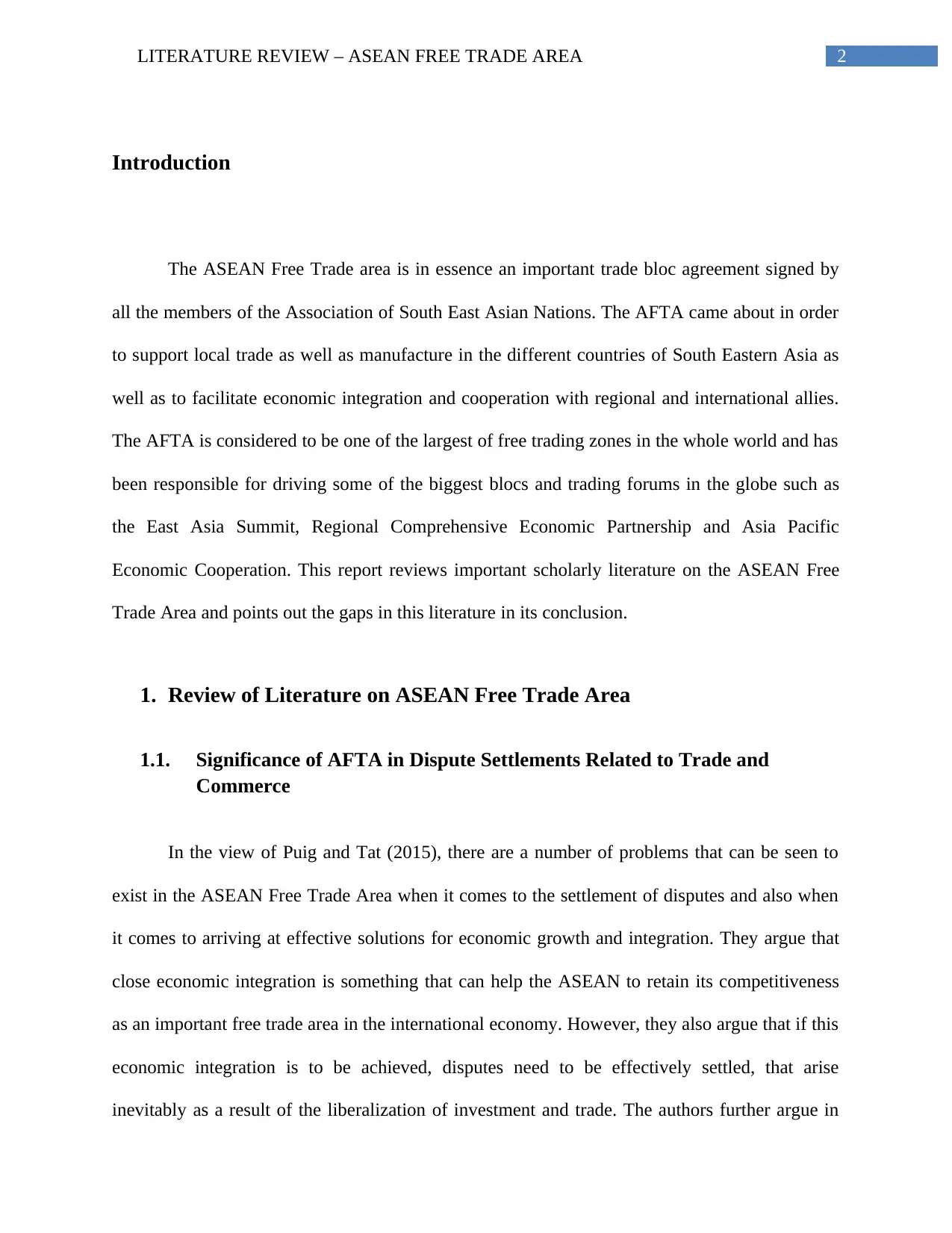
2LITERATURE REVIEW – ASEAN FREE TRADE AREA
Introduction
The ASEAN Free Trade area is in essence an important trade bloc agreement signed by
all the members of the Association of South East Asian Nations. The AFTA came about in order
to support local trade as well as manufacture in the different countries of South Eastern Asia as
well as to facilitate economic integration and cooperation with regional and international allies.
The AFTA is considered to be one of the largest of free trading zones in the whole world and has
been responsible for driving some of the biggest blocs and trading forums in the globe such as
the East Asia Summit, Regional Comprehensive Economic Partnership and Asia Pacific
Economic Cooperation. This report reviews important scholarly literature on the ASEAN Free
Trade Area and points out the gaps in this literature in its conclusion.
1. Review of Literature on ASEAN Free Trade Area
1.1. Significance of AFTA in Dispute Settlements Related to Trade and
Commerce
In the view of Puig and Tat (2015), there are a number of problems that can be seen to
exist in the ASEAN Free Trade Area when it comes to the settlement of disputes and also when
it comes to arriving at effective solutions for economic growth and integration. They argue that
close economic integration is something that can help the ASEAN to retain its competitiveness
as an important free trade area in the international economy. However, they also argue that if this
economic integration is to be achieved, disputes need to be effectively settled, that arise
inevitably as a result of the liberalization of investment and trade. The authors further argue in
Introduction
The ASEAN Free Trade area is in essence an important trade bloc agreement signed by
all the members of the Association of South East Asian Nations. The AFTA came about in order
to support local trade as well as manufacture in the different countries of South Eastern Asia as
well as to facilitate economic integration and cooperation with regional and international allies.
The AFTA is considered to be one of the largest of free trading zones in the whole world and has
been responsible for driving some of the biggest blocs and trading forums in the globe such as
the East Asia Summit, Regional Comprehensive Economic Partnership and Asia Pacific
Economic Cooperation. This report reviews important scholarly literature on the ASEAN Free
Trade Area and points out the gaps in this literature in its conclusion.
1. Review of Literature on ASEAN Free Trade Area
1.1. Significance of AFTA in Dispute Settlements Related to Trade and
Commerce
In the view of Puig and Tat (2015), there are a number of problems that can be seen to
exist in the ASEAN Free Trade Area when it comes to the settlement of disputes and also when
it comes to arriving at effective solutions for economic growth and integration. They argue that
close economic integration is something that can help the ASEAN to retain its competitiveness
as an important free trade area in the international economy. However, they also argue that if this
economic integration is to be achieved, disputes need to be effectively settled, that arise
inevitably as a result of the liberalization of investment and trade. The authors further argue in
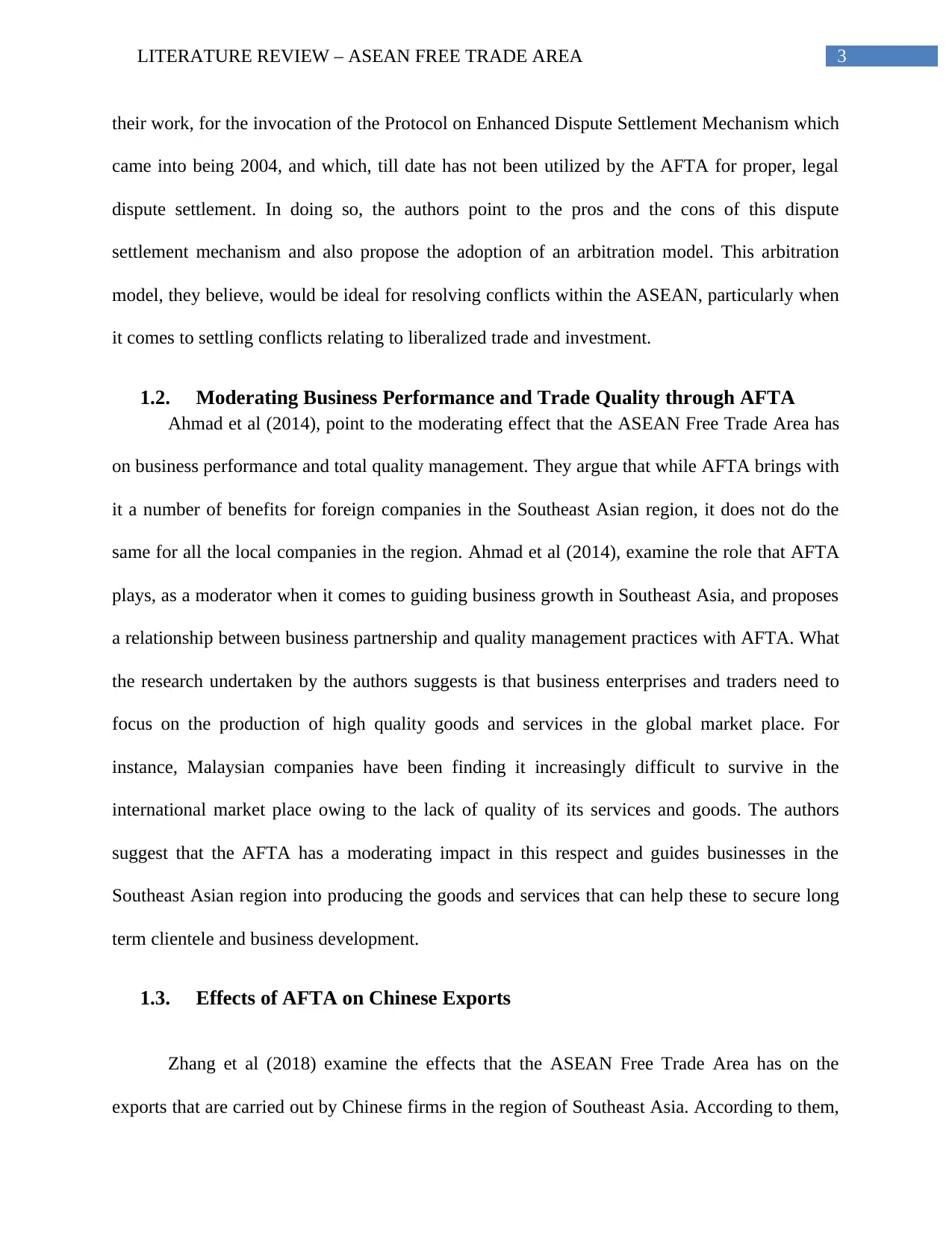
3LITERATURE REVIEW – ASEAN FREE TRADE AREA
their work, for the invocation of the Protocol on Enhanced Dispute Settlement Mechanism which
came into being 2004, and which, till date has not been utilized by the AFTA for proper, legal
dispute settlement. In doing so, the authors point to the pros and the cons of this dispute
settlement mechanism and also propose the adoption of an arbitration model. This arbitration
model, they believe, would be ideal for resolving conflicts within the ASEAN, particularly when
it comes to settling conflicts relating to liberalized trade and investment.
1.2. Moderating Business Performance and Trade Quality through AFTA
Ahmad et al (2014), point to the moderating effect that the ASEAN Free Trade Area has
on business performance and total quality management. They argue that while AFTA brings with
it a number of benefits for foreign companies in the Southeast Asian region, it does not do the
same for all the local companies in the region. Ahmad et al (2014), examine the role that AFTA
plays, as a moderator when it comes to guiding business growth in Southeast Asia, and proposes
a relationship between business partnership and quality management practices with AFTA. What
the research undertaken by the authors suggests is that business enterprises and traders need to
focus on the production of high quality goods and services in the global market place. For
instance, Malaysian companies have been finding it increasingly difficult to survive in the
international market place owing to the lack of quality of its services and goods. The authors
suggest that the AFTA has a moderating impact in this respect and guides businesses in the
Southeast Asian region into producing the goods and services that can help these to secure long
term clientele and business development.
1.3. Effects of AFTA on Chinese Exports
Zhang et al (2018) examine the effects that the ASEAN Free Trade Area has on the
exports that are carried out by Chinese firms in the region of Southeast Asia. According to them,
their work, for the invocation of the Protocol on Enhanced Dispute Settlement Mechanism which
came into being 2004, and which, till date has not been utilized by the AFTA for proper, legal
dispute settlement. In doing so, the authors point to the pros and the cons of this dispute
settlement mechanism and also propose the adoption of an arbitration model. This arbitration
model, they believe, would be ideal for resolving conflicts within the ASEAN, particularly when
it comes to settling conflicts relating to liberalized trade and investment.
1.2. Moderating Business Performance and Trade Quality through AFTA
Ahmad et al (2014), point to the moderating effect that the ASEAN Free Trade Area has
on business performance and total quality management. They argue that while AFTA brings with
it a number of benefits for foreign companies in the Southeast Asian region, it does not do the
same for all the local companies in the region. Ahmad et al (2014), examine the role that AFTA
plays, as a moderator when it comes to guiding business growth in Southeast Asia, and proposes
a relationship between business partnership and quality management practices with AFTA. What
the research undertaken by the authors suggests is that business enterprises and traders need to
focus on the production of high quality goods and services in the global market place. For
instance, Malaysian companies have been finding it increasingly difficult to survive in the
international market place owing to the lack of quality of its services and goods. The authors
suggest that the AFTA has a moderating impact in this respect and guides businesses in the
Southeast Asian region into producing the goods and services that can help these to secure long
term clientele and business development.
1.3. Effects of AFTA on Chinese Exports
Zhang et al (2018) examine the effects that the ASEAN Free Trade Area has on the
exports that are carried out by Chinese firms in the region of Southeast Asia. According to them,
Secure Best Marks with AI Grader
Need help grading? Try our AI Grader for instant feedback on your assignments.
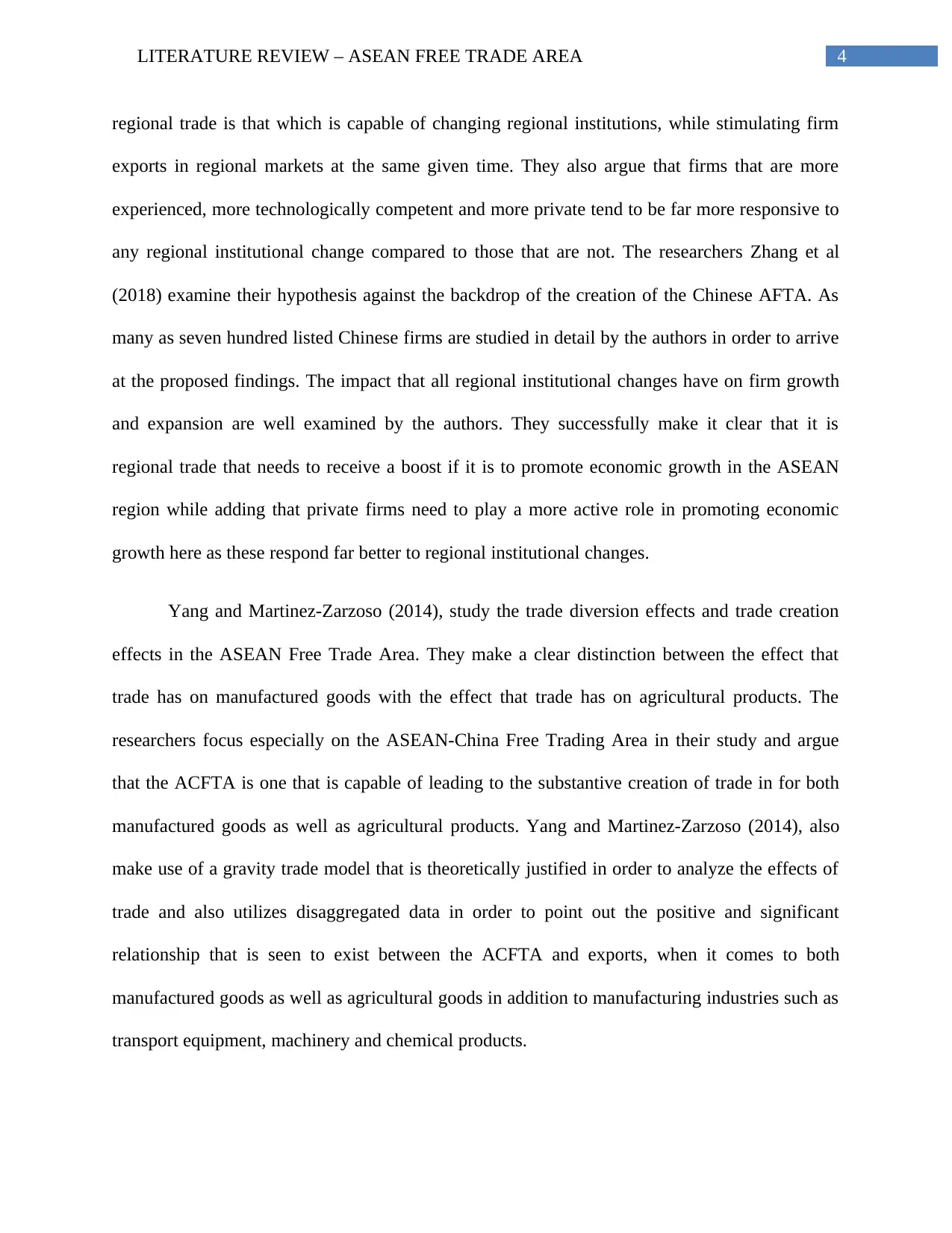
4LITERATURE REVIEW – ASEAN FREE TRADE AREA
regional trade is that which is capable of changing regional institutions, while stimulating firm
exports in regional markets at the same given time. They also argue that firms that are more
experienced, more technologically competent and more private tend to be far more responsive to
any regional institutional change compared to those that are not. The researchers Zhang et al
(2018) examine their hypothesis against the backdrop of the creation of the Chinese AFTA. As
many as seven hundred listed Chinese firms are studied in detail by the authors in order to arrive
at the proposed findings. The impact that all regional institutional changes have on firm growth
and expansion are well examined by the authors. They successfully make it clear that it is
regional trade that needs to receive a boost if it is to promote economic growth in the ASEAN
region while adding that private firms need to play a more active role in promoting economic
growth here as these respond far better to regional institutional changes.
Yang and Martinez-Zarzoso (2014), study the trade diversion effects and trade creation
effects in the ASEAN Free Trade Area. They make a clear distinction between the effect that
trade has on manufactured goods with the effect that trade has on agricultural products. The
researchers focus especially on the ASEAN-China Free Trading Area in their study and argue
that the ACFTA is one that is capable of leading to the substantive creation of trade in for both
manufactured goods as well as agricultural products. Yang and Martinez-Zarzoso (2014), also
make use of a gravity trade model that is theoretically justified in order to analyze the effects of
trade and also utilizes disaggregated data in order to point out the positive and significant
relationship that is seen to exist between the ACFTA and exports, when it comes to both
manufactured goods as well as agricultural goods in addition to manufacturing industries such as
transport equipment, machinery and chemical products.
regional trade is that which is capable of changing regional institutions, while stimulating firm
exports in regional markets at the same given time. They also argue that firms that are more
experienced, more technologically competent and more private tend to be far more responsive to
any regional institutional change compared to those that are not. The researchers Zhang et al
(2018) examine their hypothesis against the backdrop of the creation of the Chinese AFTA. As
many as seven hundred listed Chinese firms are studied in detail by the authors in order to arrive
at the proposed findings. The impact that all regional institutional changes have on firm growth
and expansion are well examined by the authors. They successfully make it clear that it is
regional trade that needs to receive a boost if it is to promote economic growth in the ASEAN
region while adding that private firms need to play a more active role in promoting economic
growth here as these respond far better to regional institutional changes.
Yang and Martinez-Zarzoso (2014), study the trade diversion effects and trade creation
effects in the ASEAN Free Trade Area. They make a clear distinction between the effect that
trade has on manufactured goods with the effect that trade has on agricultural products. The
researchers focus especially on the ASEAN-China Free Trading Area in their study and argue
that the ACFTA is one that is capable of leading to the substantive creation of trade in for both
manufactured goods as well as agricultural products. Yang and Martinez-Zarzoso (2014), also
make use of a gravity trade model that is theoretically justified in order to analyze the effects of
trade and also utilizes disaggregated data in order to point out the positive and significant
relationship that is seen to exist between the ACFTA and exports, when it comes to both
manufactured goods as well as agricultural goods in addition to manufacturing industries such as
transport equipment, machinery and chemical products.
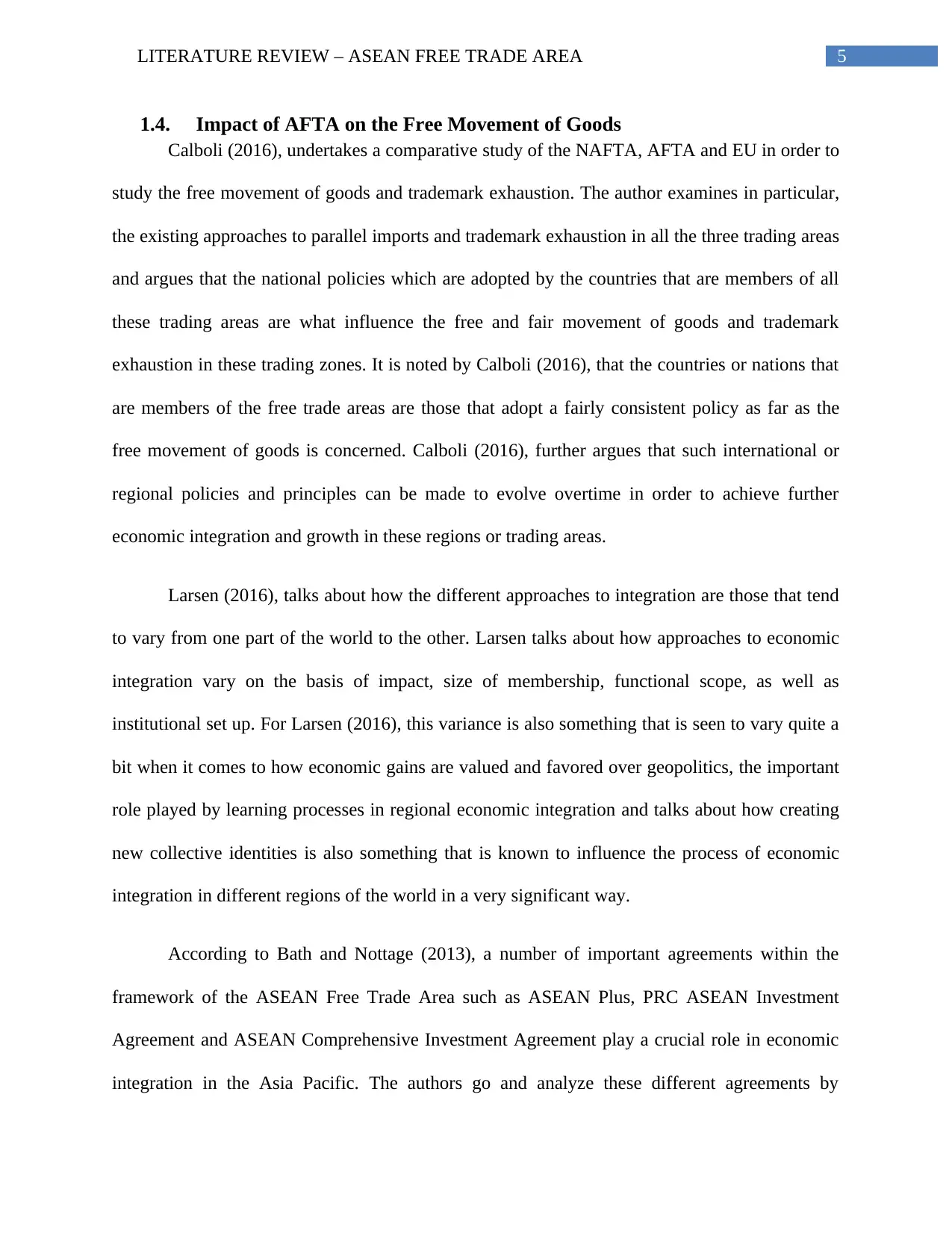
5LITERATURE REVIEW – ASEAN FREE TRADE AREA
1.4. Impact of AFTA on the Free Movement of Goods
Calboli (2016), undertakes a comparative study of the NAFTA, AFTA and EU in order to
study the free movement of goods and trademark exhaustion. The author examines in particular,
the existing approaches to parallel imports and trademark exhaustion in all the three trading areas
and argues that the national policies which are adopted by the countries that are members of all
these trading areas are what influence the free and fair movement of goods and trademark
exhaustion in these trading zones. It is noted by Calboli (2016), that the countries or nations that
are members of the free trade areas are those that adopt a fairly consistent policy as far as the
free movement of goods is concerned. Calboli (2016), further argues that such international or
regional policies and principles can be made to evolve overtime in order to achieve further
economic integration and growth in these regions or trading areas.
Larsen (2016), talks about how the different approaches to integration are those that tend
to vary from one part of the world to the other. Larsen talks about how approaches to economic
integration vary on the basis of impact, size of membership, functional scope, as well as
institutional set up. For Larsen (2016), this variance is also something that is seen to vary quite a
bit when it comes to how economic gains are valued and favored over geopolitics, the important
role played by learning processes in regional economic integration and talks about how creating
new collective identities is also something that is known to influence the process of economic
integration in different regions of the world in a very significant way.
According to Bath and Nottage (2013), a number of important agreements within the
framework of the ASEAN Free Trade Area such as ASEAN Plus, PRC ASEAN Investment
Agreement and ASEAN Comprehensive Investment Agreement play a crucial role in economic
integration in the Asia Pacific. The authors go and analyze these different agreements by
1.4. Impact of AFTA on the Free Movement of Goods
Calboli (2016), undertakes a comparative study of the NAFTA, AFTA and EU in order to
study the free movement of goods and trademark exhaustion. The author examines in particular,
the existing approaches to parallel imports and trademark exhaustion in all the three trading areas
and argues that the national policies which are adopted by the countries that are members of all
these trading areas are what influence the free and fair movement of goods and trademark
exhaustion in these trading zones. It is noted by Calboli (2016), that the countries or nations that
are members of the free trade areas are those that adopt a fairly consistent policy as far as the
free movement of goods is concerned. Calboli (2016), further argues that such international or
regional policies and principles can be made to evolve overtime in order to achieve further
economic integration and growth in these regions or trading areas.
Larsen (2016), talks about how the different approaches to integration are those that tend
to vary from one part of the world to the other. Larsen talks about how approaches to economic
integration vary on the basis of impact, size of membership, functional scope, as well as
institutional set up. For Larsen (2016), this variance is also something that is seen to vary quite a
bit when it comes to how economic gains are valued and favored over geopolitics, the important
role played by learning processes in regional economic integration and talks about how creating
new collective identities is also something that is known to influence the process of economic
integration in different regions of the world in a very significant way.
According to Bath and Nottage (2013), a number of important agreements within the
framework of the ASEAN Free Trade Area such as ASEAN Plus, PRC ASEAN Investment
Agreement and ASEAN Comprehensive Investment Agreement play a crucial role in economic
integration in the Asia Pacific. The authors go and analyze these different agreements by
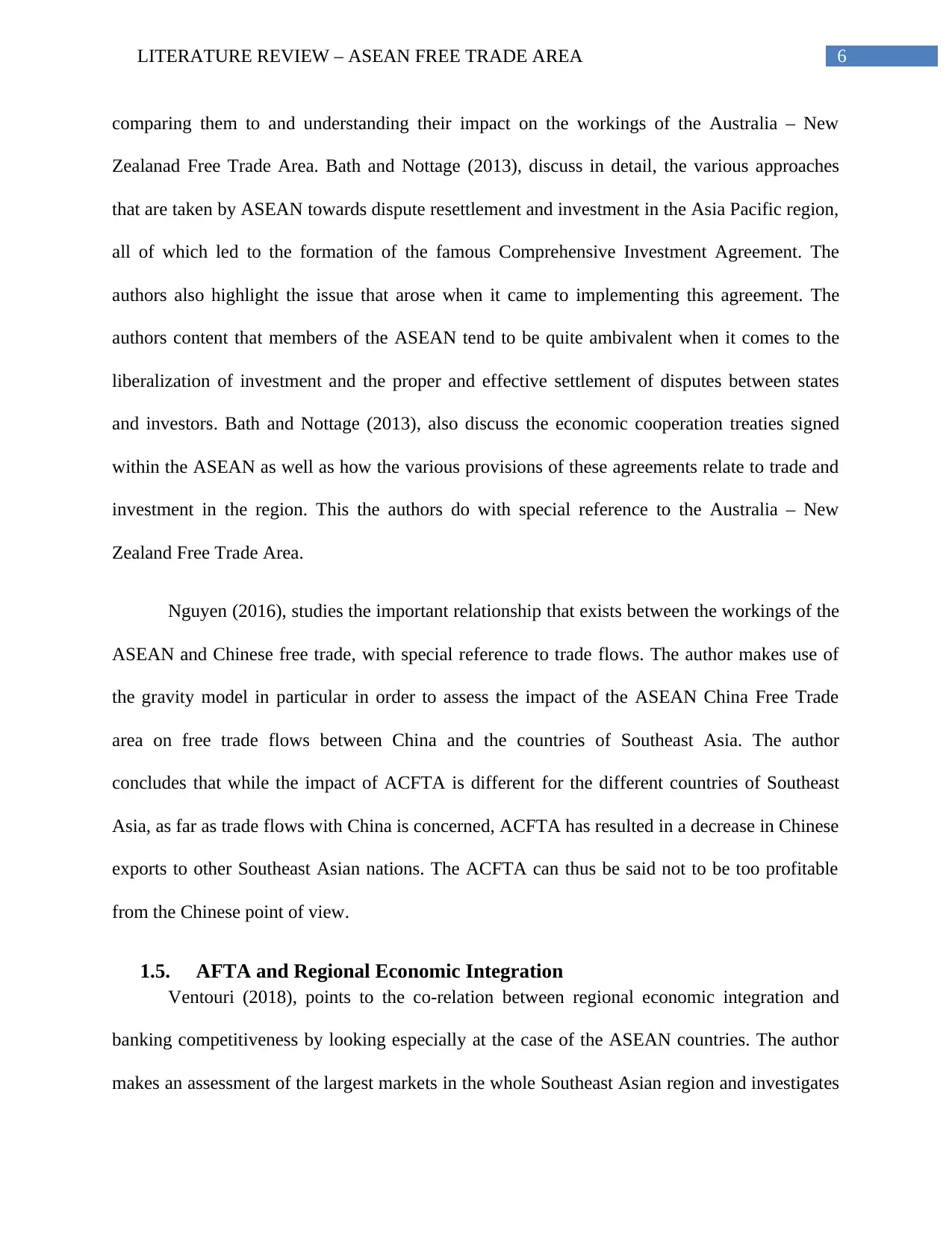
6LITERATURE REVIEW – ASEAN FREE TRADE AREA
comparing them to and understanding their impact on the workings of the Australia – New
Zealanad Free Trade Area. Bath and Nottage (2013), discuss in detail, the various approaches
that are taken by ASEAN towards dispute resettlement and investment in the Asia Pacific region,
all of which led to the formation of the famous Comprehensive Investment Agreement. The
authors also highlight the issue that arose when it came to implementing this agreement. The
authors content that members of the ASEAN tend to be quite ambivalent when it comes to the
liberalization of investment and the proper and effective settlement of disputes between states
and investors. Bath and Nottage (2013), also discuss the economic cooperation treaties signed
within the ASEAN as well as how the various provisions of these agreements relate to trade and
investment in the region. This the authors do with special reference to the Australia – New
Zealand Free Trade Area.
Nguyen (2016), studies the important relationship that exists between the workings of the
ASEAN and Chinese free trade, with special reference to trade flows. The author makes use of
the gravity model in particular in order to assess the impact of the ASEAN China Free Trade
area on free trade flows between China and the countries of Southeast Asia. The author
concludes that while the impact of ACFTA is different for the different countries of Southeast
Asia, as far as trade flows with China is concerned, ACFTA has resulted in a decrease in Chinese
exports to other Southeast Asian nations. The ACFTA can thus be said not to be too profitable
from the Chinese point of view.
1.5. AFTA and Regional Economic Integration
Ventouri (2018), points to the co-relation between regional economic integration and
banking competitiveness by looking especially at the case of the ASEAN countries. The author
makes an assessment of the largest markets in the whole Southeast Asian region and investigates
comparing them to and understanding their impact on the workings of the Australia – New
Zealanad Free Trade Area. Bath and Nottage (2013), discuss in detail, the various approaches
that are taken by ASEAN towards dispute resettlement and investment in the Asia Pacific region,
all of which led to the formation of the famous Comprehensive Investment Agreement. The
authors also highlight the issue that arose when it came to implementing this agreement. The
authors content that members of the ASEAN tend to be quite ambivalent when it comes to the
liberalization of investment and the proper and effective settlement of disputes between states
and investors. Bath and Nottage (2013), also discuss the economic cooperation treaties signed
within the ASEAN as well as how the various provisions of these agreements relate to trade and
investment in the region. This the authors do with special reference to the Australia – New
Zealand Free Trade Area.
Nguyen (2016), studies the important relationship that exists between the workings of the
ASEAN and Chinese free trade, with special reference to trade flows. The author makes use of
the gravity model in particular in order to assess the impact of the ASEAN China Free Trade
area on free trade flows between China and the countries of Southeast Asia. The author
concludes that while the impact of ACFTA is different for the different countries of Southeast
Asia, as far as trade flows with China is concerned, ACFTA has resulted in a decrease in Chinese
exports to other Southeast Asian nations. The ACFTA can thus be said not to be too profitable
from the Chinese point of view.
1.5. AFTA and Regional Economic Integration
Ventouri (2018), points to the co-relation between regional economic integration and
banking competitiveness by looking especially at the case of the ASEAN countries. The author
makes an assessment of the largest markets in the whole Southeast Asian region and investigates
Paraphrase This Document
Need a fresh take? Get an instant paraphrase of this document with our AI Paraphraser
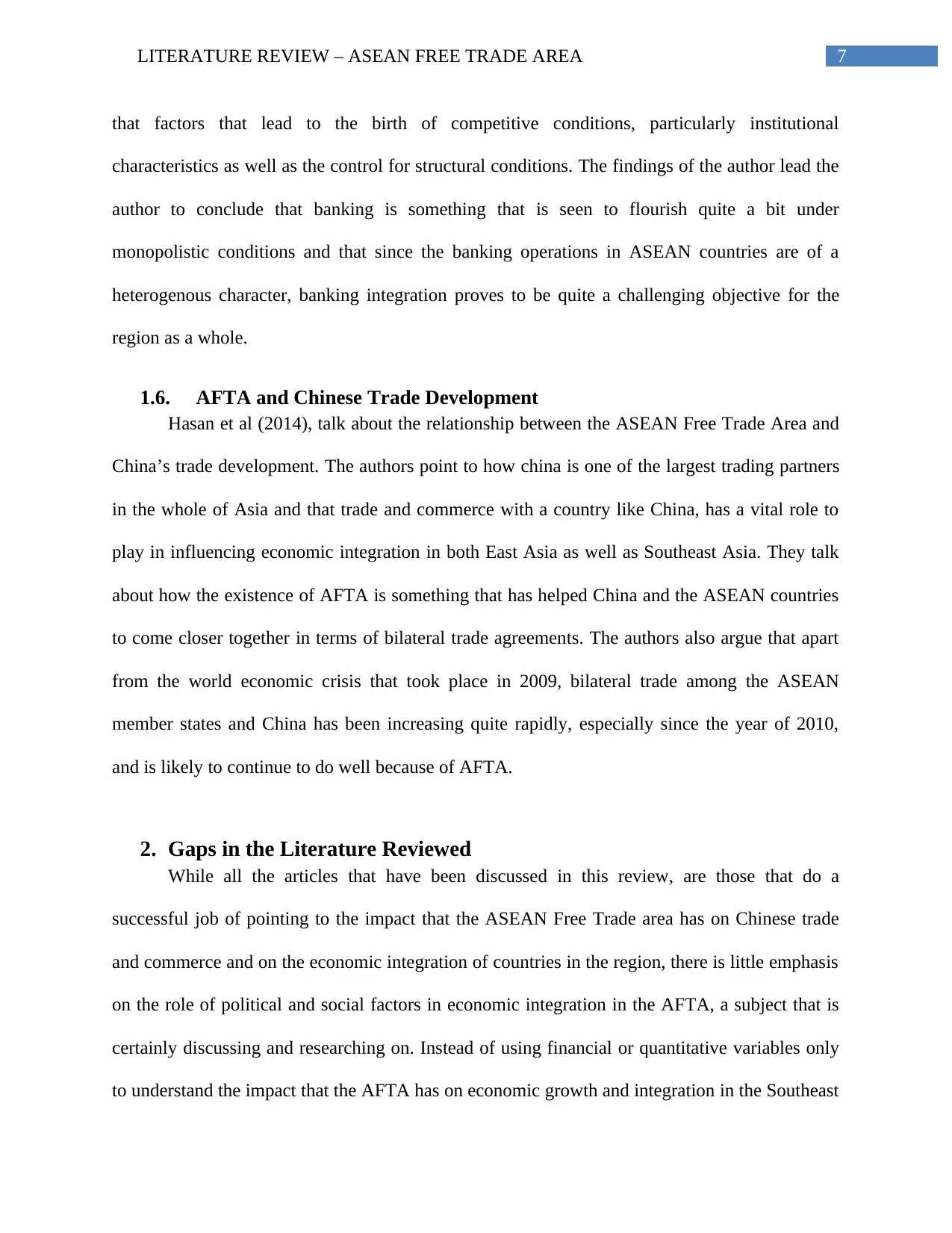
7LITERATURE REVIEW – ASEAN FREE TRADE AREA
that factors that lead to the birth of competitive conditions, particularly institutional
characteristics as well as the control for structural conditions. The findings of the author lead the
author to conclude that banking is something that is seen to flourish quite a bit under
monopolistic conditions and that since the banking operations in ASEAN countries are of a
heterogenous character, banking integration proves to be quite a challenging objective for the
region as a whole.
1.6. AFTA and Chinese Trade Development
Hasan et al (2014), talk about the relationship between the ASEAN Free Trade Area and
China’s trade development. The authors point to how china is one of the largest trading partners
in the whole of Asia and that trade and commerce with a country like China, has a vital role to
play in influencing economic integration in both East Asia as well as Southeast Asia. They talk
about how the existence of AFTA is something that has helped China and the ASEAN countries
to come closer together in terms of bilateral trade agreements. The authors also argue that apart
from the world economic crisis that took place in 2009, bilateral trade among the ASEAN
member states and China has been increasing quite rapidly, especially since the year of 2010,
and is likely to continue to do well because of AFTA.
2. Gaps in the Literature Reviewed
While all the articles that have been discussed in this review, are those that do a
successful job of pointing to the impact that the ASEAN Free Trade area has on Chinese trade
and commerce and on the economic integration of countries in the region, there is little emphasis
on the role of political and social factors in economic integration in the AFTA, a subject that is
certainly discussing and researching on. Instead of using financial or quantitative variables only
to understand the impact that the AFTA has on economic growth and integration in the Southeast
that factors that lead to the birth of competitive conditions, particularly institutional
characteristics as well as the control for structural conditions. The findings of the author lead the
author to conclude that banking is something that is seen to flourish quite a bit under
monopolistic conditions and that since the banking operations in ASEAN countries are of a
heterogenous character, banking integration proves to be quite a challenging objective for the
region as a whole.
1.6. AFTA and Chinese Trade Development
Hasan et al (2014), talk about the relationship between the ASEAN Free Trade Area and
China’s trade development. The authors point to how china is one of the largest trading partners
in the whole of Asia and that trade and commerce with a country like China, has a vital role to
play in influencing economic integration in both East Asia as well as Southeast Asia. They talk
about how the existence of AFTA is something that has helped China and the ASEAN countries
to come closer together in terms of bilateral trade agreements. The authors also argue that apart
from the world economic crisis that took place in 2009, bilateral trade among the ASEAN
member states and China has been increasing quite rapidly, especially since the year of 2010,
and is likely to continue to do well because of AFTA.
2. Gaps in the Literature Reviewed
While all the articles that have been discussed in this review, are those that do a
successful job of pointing to the impact that the ASEAN Free Trade area has on Chinese trade
and commerce and on the economic integration of countries in the region, there is little emphasis
on the role of political and social factors in economic integration in the AFTA, a subject that is
certainly discussing and researching on. Instead of using financial or quantitative variables only
to understand the impact that the AFTA has on economic growth and integration in the Southeast
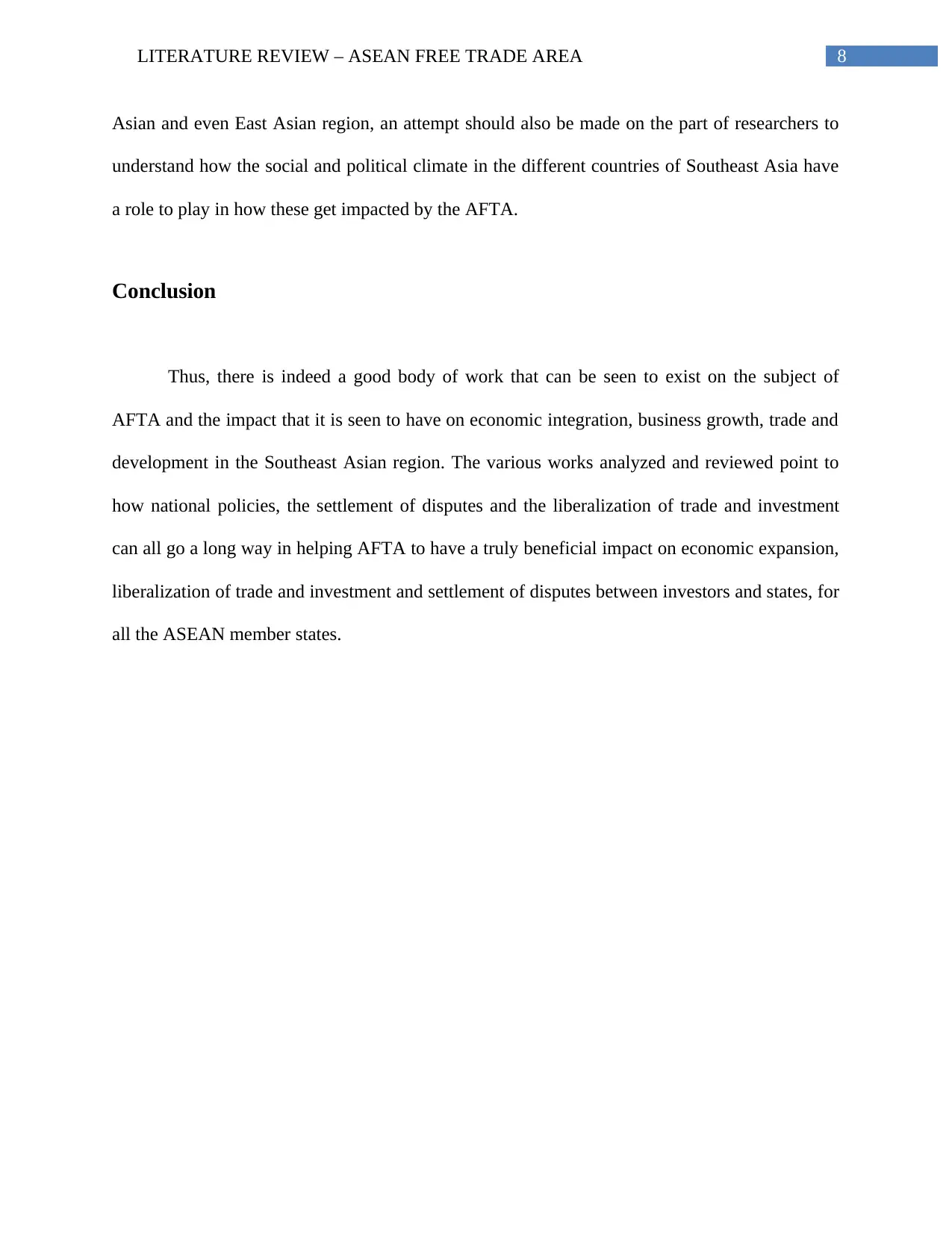
8LITERATURE REVIEW – ASEAN FREE TRADE AREA
Asian and even East Asian region, an attempt should also be made on the part of researchers to
understand how the social and political climate in the different countries of Southeast Asia have
a role to play in how these get impacted by the AFTA.
Conclusion
Thus, there is indeed a good body of work that can be seen to exist on the subject of
AFTA and the impact that it is seen to have on economic integration, business growth, trade and
development in the Southeast Asian region. The various works analyzed and reviewed point to
how national policies, the settlement of disputes and the liberalization of trade and investment
can all go a long way in helping AFTA to have a truly beneficial impact on economic expansion,
liberalization of trade and investment and settlement of disputes between investors and states, for
all the ASEAN member states.
Asian and even East Asian region, an attempt should also be made on the part of researchers to
understand how the social and political climate in the different countries of Southeast Asia have
a role to play in how these get impacted by the AFTA.
Conclusion
Thus, there is indeed a good body of work that can be seen to exist on the subject of
AFTA and the impact that it is seen to have on economic integration, business growth, trade and
development in the Southeast Asian region. The various works analyzed and reviewed point to
how national policies, the settlement of disputes and the liberalization of trade and investment
can all go a long way in helping AFTA to have a truly beneficial impact on economic expansion,
liberalization of trade and investment and settlement of disputes between investors and states, for
all the ASEAN member states.
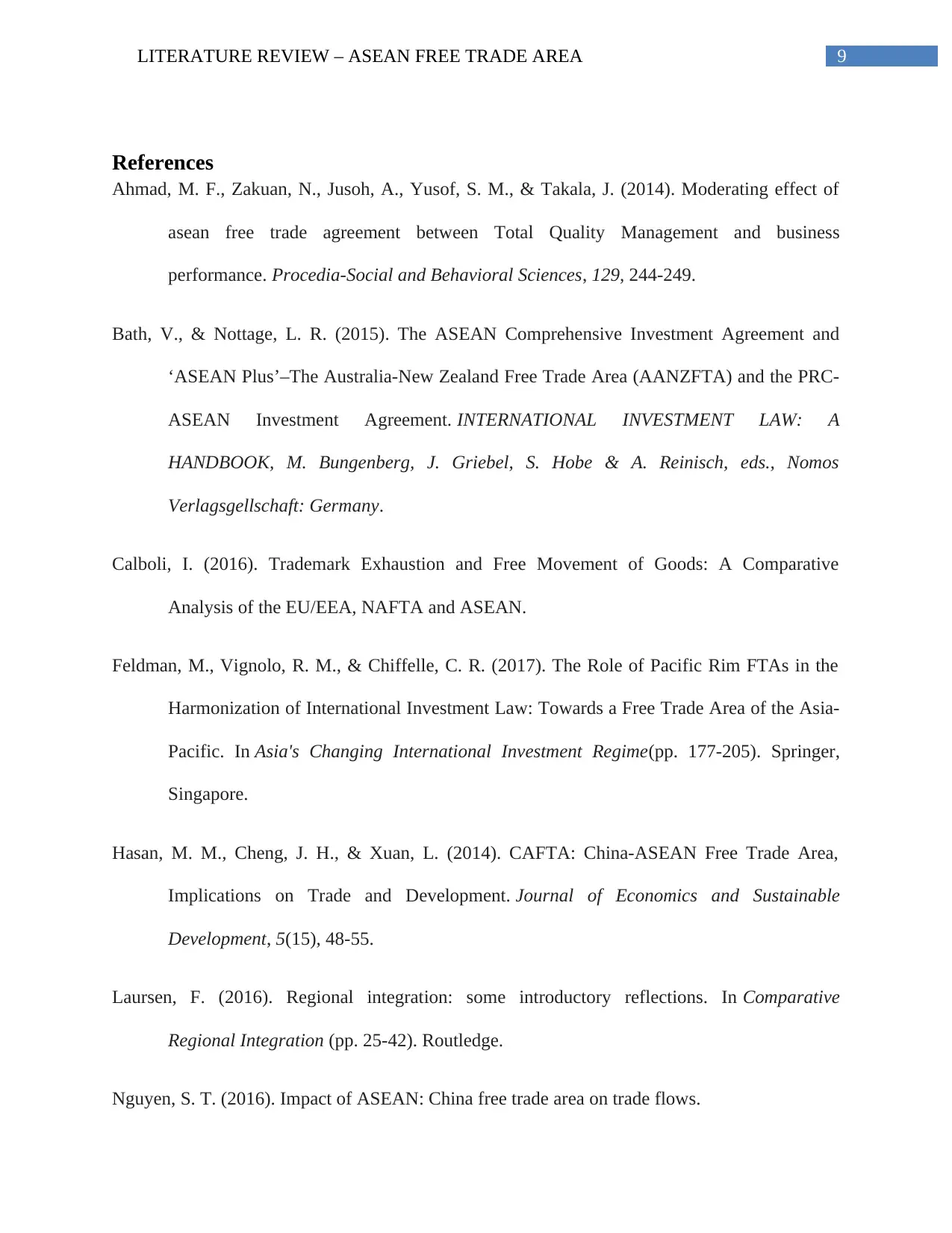
9LITERATURE REVIEW – ASEAN FREE TRADE AREA
References
Ahmad, M. F., Zakuan, N., Jusoh, A., Yusof, S. M., & Takala, J. (2014). Moderating effect of
asean free trade agreement between Total Quality Management and business
performance. Procedia-Social and Behavioral Sciences, 129, 244-249.
Bath, V., & Nottage, L. R. (2015). The ASEAN Comprehensive Investment Agreement and
‘ASEAN Plus’–The Australia-New Zealand Free Trade Area (AANZFTA) and the PRC-
ASEAN Investment Agreement. INTERNATIONAL INVESTMENT LAW: A
HANDBOOK, M. Bungenberg, J. Griebel, S. Hobe & A. Reinisch, eds., Nomos
Verlagsgellschaft: Germany.
Calboli, I. (2016). Trademark Exhaustion and Free Movement of Goods: A Comparative
Analysis of the EU/EEA, NAFTA and ASEAN.
Feldman, M., Vignolo, R. M., & Chiffelle, C. R. (2017). The Role of Pacific Rim FTAs in the
Harmonization of International Investment Law: Towards a Free Trade Area of the Asia-
Pacific. In Asia's Changing International Investment Regime(pp. 177-205). Springer,
Singapore.
Hasan, M. M., Cheng, J. H., & Xuan, L. (2014). CAFTA: China-ASEAN Free Trade Area,
Implications on Trade and Development. Journal of Economics and Sustainable
Development, 5(15), 48-55.
Laursen, F. (2016). Regional integration: some introductory reflections. In Comparative
Regional Integration (pp. 25-42). Routledge.
Nguyen, S. T. (2016). Impact of ASEAN: China free trade area on trade flows.
References
Ahmad, M. F., Zakuan, N., Jusoh, A., Yusof, S. M., & Takala, J. (2014). Moderating effect of
asean free trade agreement between Total Quality Management and business
performance. Procedia-Social and Behavioral Sciences, 129, 244-249.
Bath, V., & Nottage, L. R. (2015). The ASEAN Comprehensive Investment Agreement and
‘ASEAN Plus’–The Australia-New Zealand Free Trade Area (AANZFTA) and the PRC-
ASEAN Investment Agreement. INTERNATIONAL INVESTMENT LAW: A
HANDBOOK, M. Bungenberg, J. Griebel, S. Hobe & A. Reinisch, eds., Nomos
Verlagsgellschaft: Germany.
Calboli, I. (2016). Trademark Exhaustion and Free Movement of Goods: A Comparative
Analysis of the EU/EEA, NAFTA and ASEAN.
Feldman, M., Vignolo, R. M., & Chiffelle, C. R. (2017). The Role of Pacific Rim FTAs in the
Harmonization of International Investment Law: Towards a Free Trade Area of the Asia-
Pacific. In Asia's Changing International Investment Regime(pp. 177-205). Springer,
Singapore.
Hasan, M. M., Cheng, J. H., & Xuan, L. (2014). CAFTA: China-ASEAN Free Trade Area,
Implications on Trade and Development. Journal of Economics and Sustainable
Development, 5(15), 48-55.
Laursen, F. (2016). Regional integration: some introductory reflections. In Comparative
Regional Integration (pp. 25-42). Routledge.
Nguyen, S. T. (2016). Impact of ASEAN: China free trade area on trade flows.
Secure Best Marks with AI Grader
Need help grading? Try our AI Grader for instant feedback on your assignments.
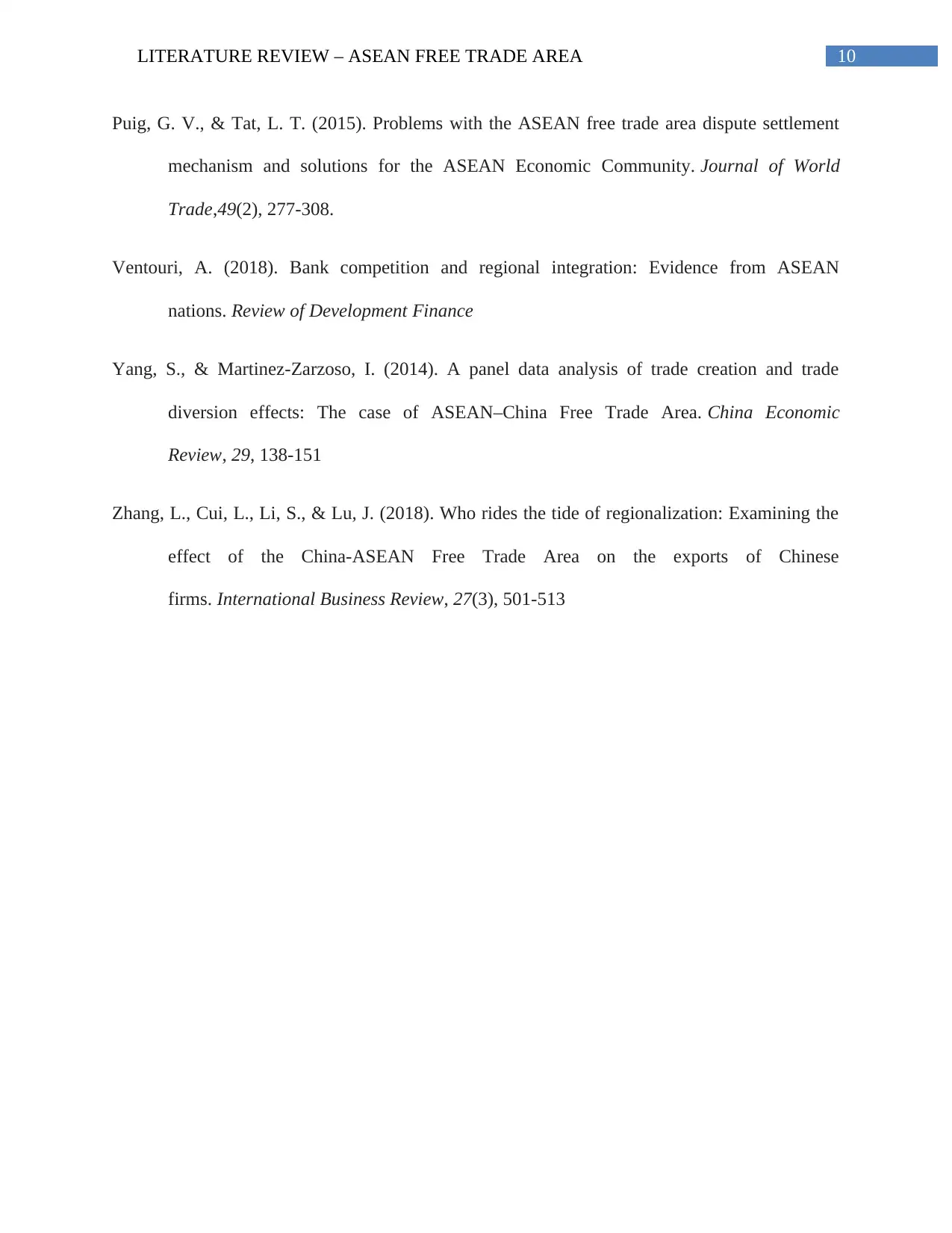
10LITERATURE REVIEW – ASEAN FREE TRADE AREA
Puig, G. V., & Tat, L. T. (2015). Problems with the ASEAN free trade area dispute settlement
mechanism and solutions for the ASEAN Economic Community. Journal of World
Trade,49(2), 277-308.
Ventouri, A. (2018). Bank competition and regional integration: Evidence from ASEAN
nations. Review of Development Finance
Yang, S., & Martinez-Zarzoso, I. (2014). A panel data analysis of trade creation and trade
diversion effects: The case of ASEAN–China Free Trade Area. China Economic
Review, 29, 138-151
Zhang, L., Cui, L., Li, S., & Lu, J. (2018). Who rides the tide of regionalization: Examining the
effect of the China-ASEAN Free Trade Area on the exports of Chinese
firms. International Business Review, 27(3), 501-513
Puig, G. V., & Tat, L. T. (2015). Problems with the ASEAN free trade area dispute settlement
mechanism and solutions for the ASEAN Economic Community. Journal of World
Trade,49(2), 277-308.
Ventouri, A. (2018). Bank competition and regional integration: Evidence from ASEAN
nations. Review of Development Finance
Yang, S., & Martinez-Zarzoso, I. (2014). A panel data analysis of trade creation and trade
diversion effects: The case of ASEAN–China Free Trade Area. China Economic
Review, 29, 138-151
Zhang, L., Cui, L., Li, S., & Lu, J. (2018). Who rides the tide of regionalization: Examining the
effect of the China-ASEAN Free Trade Area on the exports of Chinese
firms. International Business Review, 27(3), 501-513
1 out of 11
Your All-in-One AI-Powered Toolkit for Academic Success.
+13062052269
info@desklib.com
Available 24*7 on WhatsApp / Email
![[object Object]](/_next/static/media/star-bottom.7253800d.svg)
Unlock your academic potential
© 2024 | Zucol Services PVT LTD | All rights reserved.

